
The 386th Air Expeditionary Wing (386 AEW) is a provisional United States Air Force unit assigned to United States Air Forces Central. As a provisional unit, it may be activated or inactivated at any time. It is currently stationed at Ali Al Salem Air Base, Kuwait in Southwest Asia. During World War II, the group's predecessor unit, the 386th Bombardment Group (Medium) was a B-26 Marauder bombardment group assigned to the Eighth and later Ninth Air Force. During the Battle of Normandy, it supported Allied forces at Caen, and participated in the massive blows against the enemy at Saint-Lô on 25 July 1944. The unit knocked out targets to help clear the Falaise pocket of German forces in August 1944 and hit strong points at Brest during September.

The 416th Air Expeditionary Wing (AEW) is a provisional unit assigned to the Air Combat Command of the United States Air Force to activate or inactivate as needed.

The 409th Air Expeditionary Group is a provisional United States Air Force unit assigned to United States Air Forces Europe (USAFE), which may activate or inactivate the group as needed at any time.
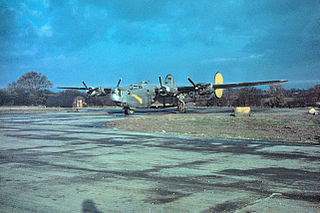
The 847th Bombardment Squadron is a former United States Army Air Forces unit that was originally activated as the 421st Bombardment Squadron. Its last assignment was with the 489th Bombardment Group at Great Bend Army Air Field, Kansas where it was inactivated on 28 March 1945. As the 20th Antisubmarine Squadron, the squadron performed antisubmarine patrols in 1942 and 1943. After reforming as a heavy bomber squadron, it engaged in the strategic bombing campaign against Germany in the European Theater of Operations until returning to the United States in late 1944. The squadron was inactivated while its parent group was training as a very heavy bombardment unit.

The 835th Bombardment Squadron is an inactive United States Army Air Forces unit. It was activated in January 1941 as the 80th Bombardment Squadron and equipped with Douglas A-20 Havoc light bombers. Following the attack on Pearl Harbor the squadron began to fly antisubmarine patrols off the Atlantic coast and over the Caribbean Sea, becoming the 9th Antisubmarine Squadron.

The 97th Bombardment Wing is an inactive United States Army Air Forces unit. Its last assignment was with 9th Bombardment Division, at Camp Shanks, New York, where it was inactivated on 11 October 1945.
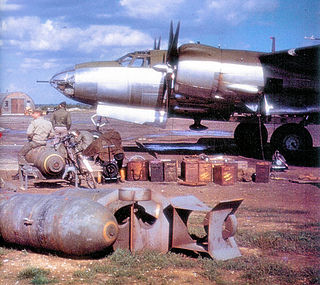
The 494th Bombardment Squadron is an inactive United States Air Force unit, assigned to the 344th Bombardment Group, The squadron was activated in September 1942, and until July 1943 served as a Replacement Training Unit. It then began training for combat operations, deploying to the European Theater of Operations in January 1944. It participated in combat, earning a Distinguished Unit Citation for air support of ground troops during Operation Cobra. After V-E Day, the squadron became part of the occupation forces until it was inactivated on 31 March 1946.
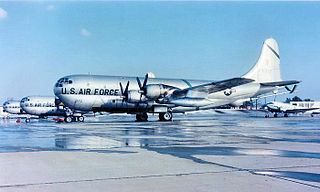
The 641st Bombardment Squadron is an inactive United States Air Force unit. After training with Douglas A-20 Havocs in the United States the squadron deployed to the European Theater of World War II, where it engaged in combat until the Surrender of Germany. It was last assigned to the 409th Bombardment Group at Westover Field, Massachusetts, where it was inactivated on 7 November 1945.
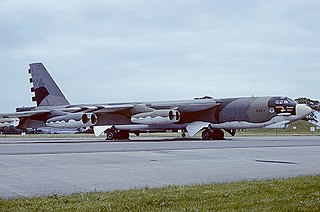
The 644th Bomb Squadron is an inactive United States Air Force unit. It was last assigned to the 410th Bombardment Wing at K. I. Sawyer Air Force Base, Michigan, where it was inactivated on 21 November 1994.

The 668th Bomb Squadron is an inactive United States Air Force unit. It was last assigned to the 416th Operations Group at Griffiss Air Force Base, New York, where it was inactivated on 1 January 1995.

The 671st Bombardment Squadron is a former United States Army Air Forces unit, assigned to the 416th Bombardment Group. The squadron was activated a medium bomber unit during World War II. It trained in the United States before deploying to the European Theater of Operations, where it served with Ninth Air Force. It moved to the continent of Europe following D-Day and continued operations until the end of the war, earning a Distinguished Unit Citation for its actions in combat. It returned to the United States in the fall of 1945 and was inactivated at the port of embarkation.

The 670th Bombardment Squadron is a former United States Army Air Forces unit, assigned to the 416th Bombardment Group. The squadron was activated a medium bomber unit during World War II. It trained in the United States before deploying to the European Theater of Operations, where it served with Ninth Air Force. It moved to the continent of Europe following D-Day and continued operations until the end of the war, earning a Distinguished Unit Citation for its actions in combat. It returned to the United States in the fall of 1945 and was inactivated at the port of embarkation.

The 647th Bombardment Squadron is a former United States Army Air Forces unit, activated during World War II. The squadron moved to the European Theater of Operations in the spring of 1944. It flew air support and air interdiction missions with Douglas A-20 Havoc bombers, first from England, then from Advanced Landing Grounds on the European continent. It received a Distinguished Unit Citation for missions flown against German targets during the Battle of the Bulge. In February 1945, the unit began converting to the Douglas A-26 Invader, but the war ended before it flew any combat missions with its new aircraft. It returned to the United States in the summer of 1945 and was inactivated at Myrtle Beach Army Air Field, South Carolina on 7 November 1945.

The 646th Bombardment Squadron is a former United States Army Air Forces unit, activated during World War II. The squadron moved to the European Theater of Operations in the spring of 1944. It flew air support and air interdiction missions with Douglas A-20 Havoc bombers, first from England, then from Advanced Landing Grounds on the European continent. It received a Distinguished Unit Citation for missions flown against German targets during the Battle of the Bulge. In February 1945, the unit began converting to the Douglas A-26 Invader, but the war ended before it flew any combat missions with its new aircraft. It returned to the United States in the summer of 1945 and was inactivated at Myrtle Beach Army Air Field, South Carolina on 7 November 1945.

The 645th Bombardment Squadron is a former United States Army Air Forces unit, activated during World War II. The squadron moved to the European Theater of Operations in the spring of 1944. It flew air support and air interdiction missions with Douglas A-20 Havoc bombers, first from England, then from Advanced Landing Grounds on the European continent. It received a Distinguished Unit Citation for missions flown against German targets during the Battle of the Bulge. In February 1945, the unit began converting to the Douglas A-26 Invader, but the war ended before it flew any combat missions with its new aircraft. It returned to the United States in the summer of 1945 and was inactivated at Myrtle Beach Army Air Field, South Carolina on 7 November 1945.

The 839th Bombardment Squadron is an inactive United States Army Air Forces unit. It was activated in January 1941 as the 79th Bombardment Squadron and equipped with Douglas A-20 Havoc light bombers. Following the attack on Pearl Harbor the squadron began to fly antisubmarine patrols off the Atlantic coast and over the Caribbean Sea, becoming the 8th Antisubmarine Squadron.
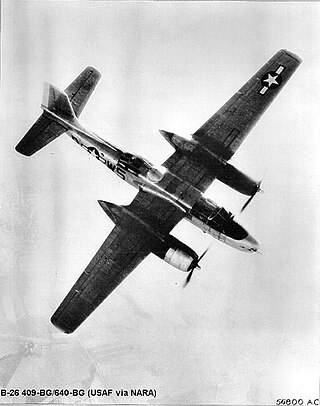
The 642d Bombardment Squadron is an inactive United States Army Air Forces unit. After training with Douglas A-20 Havocs in the United States the squadron deployed to the European Theater of World War II, where it engaged in combat until the Surrender of Germany. It was last assigned to the 409th Bombardment Group at Westover Field, Massachusetts, where it was inactivated on 7 November 1945.

The 643d Bombardment Squadron is an inactive United States Army Air Forces unit. After training with Douglas A-20 Havocs in the United States the squadron deployed to the European Theater of World War II, where it engaged in combat until the Surrender of Germany. It was last assigned to the 409th Bombardment Group at Westover Field, Massachusetts, where it was inactivated on 7 November 1945.

The 508th Fighter Squadron is an inactive United States Army Air Forces unit. It was last assigned to the 404th Fighter Group at Drew Field, Florida, where it was inactivated on 9 November 1945. The squadron saw combat in the European Theater of Operations with Ninth Air Force as a fighter-bomber unit during World War II. It was decorated by the American, French, and Belgian governments for its actions during the war.

The 377th Fighter Squadron is a United States Air Force active duty unit stationed at Montgomery Air National Guard Base, Alabama. It is an Active Associate Unit administratively assigned to the 495th Fighter Group at Shaw Air Force Base, South Carolina and integrated operationally with the 100th Fighter Squadron of the Alabama Air National Guard’s 187th Fighter Wing.


















